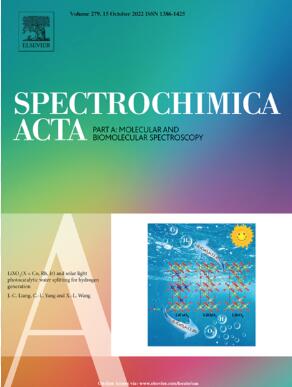Templating assisted fabrication of flexible, highly stable and uniform plasmonic platform for ultrahigh enhancement of Raman and fluorescence signals: Model sensing of rhodamine-6G
IF 4.3
2区 化学
Q1 SPECTROSCOPY
Spectrochimica Acta Part A: Molecular and Biomolecular Spectroscopy
Pub Date : 2025-04-01
DOI:10.1016/j.saa.2025.126125
引用次数: 0
Abstract
Raman-fluorescence dual enhancement offers transformative potential in fields like biosensing and bioimaging, combining exceptional sensitivity with rapid response. In this study, a novel flexible plasmonic platform, composed of silver nanocolumns (Ag-NCOLs) embedded in polydimethylsiloxane (PDMS), was investigated using 4-aminothiophenol (4-ATP) for Raman and rhodamine-6G (R6G) for fluorescence studies. This platform demonstrated remarkable enhancement factors (EFs) of ∼1014 for Raman and ∼273 for fluorescence, surpassing Ag-NCOLs on silicon (Si) by factors of 10 and 24.8, respectively. A number of control experiments confirmed the platform’s uniformity, long-term stability, and flexibility (bending and stretching). The system’s efficacy was validated through R6G detection, achieving detection limits of 0.54 nM for Raman and 0.26 nM for fluorescence. These findings establish the platform as a promising tool for diverse applications, including label-free and labeled biosensing, pathogen detection, bioimaging, in vitro diagnostics, wearable sensors, material characterization, and environmental monitoring. This work underscores the immense potential of flexible plasmonic platforms for advancing next-generation sensing and imaging technologies.

求助全文
约1分钟内获得全文
求助全文
来源期刊
CiteScore
8.40
自引率
11.40%
发文量
1364
审稿时长
40 days
期刊介绍:
Spectrochimica Acta, Part A: Molecular and Biomolecular Spectroscopy (SAA) is an interdisciplinary journal which spans from basic to applied aspects of optical spectroscopy in chemistry, medicine, biology, and materials science.
The journal publishes original scientific papers that feature high-quality spectroscopic data and analysis. From the broad range of optical spectroscopies, the emphasis is on electronic, vibrational or rotational spectra of molecules, rather than on spectroscopy based on magnetic moments.
Criteria for publication in SAA are novelty, uniqueness, and outstanding quality. Routine applications of spectroscopic techniques and computational methods are not appropriate.
Topics of particular interest of Spectrochimica Acta Part A include, but are not limited to:
Spectroscopy and dynamics of bioanalytical, biomedical, environmental, and atmospheric sciences,
Novel experimental techniques or instrumentation for molecular spectroscopy,
Novel theoretical and computational methods,
Novel applications in photochemistry and photobiology,
Novel interpretational approaches as well as advances in data analysis based on electronic or vibrational spectroscopy.

 求助内容:
求助内容: 应助结果提醒方式:
应助结果提醒方式:


